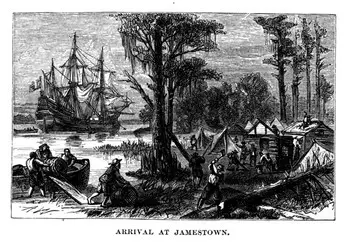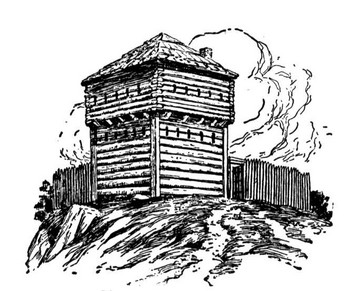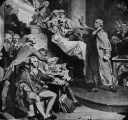Click and go to find today's lesson: Investigating the First Thanksgiving
Once you have finished your investigation of the Pilgrims and Wampanoag Indians, you will write a historical fiction story. Try looking at these links to get some ideas:
Short story: The Gift of the Magi
Short story: To Build a Fire
Short story: The Treasure in the Forest
How to write historical fiction
10 Tips for writing historical fiction
The Constitution

The Constitution
Monday, October 26, 2015
Friday, October 23, 2015
Jamestown Interactive
This is a really cool site that allows you to see what Jamestown and the local Native American villages may have looked like. Feel free to explore!
Jamestown Interactive
Jamestown Interactive
Tuesday, October 20, 2015
On the Trail with John Smith
On The Trail With Captain John Smith
Go through every step of the site.
Jamestown: First Successful English Colony in America
Explorers had been landing in America for some time before English settlers arrived in what is now Jamestown, Virginia, in 1607. But it was in that spot on the James River that English colonization began and with it, the history of America.
James I was king of England at that time, and he had granted approval for a group of businesspeople to settle in this new land. They were part of the Virginia Company, and they got the go-ahead in 1606. By December of that year, the expedition was ready.
 In all, 214 people set sail for America. They reached it on May 14, 1607. Very soon after they landed, the English found themselves under attack from Algonquins, a Native American tribe who had been living in that area for some time and who didn't exactly welcome new settlers. The English managed to drive off the attackers, who came back every now and then. The English, however, were there to stay.
In all, 214 people set sail for America. They reached it on May 14, 1607. Very soon after they landed, the English found themselves under attack from Algonquins, a Native American tribe who had been living in that area for some time and who didn't exactly welcome new settlers. The English managed to drive off the attackers, who came back every now and then. The English, however, were there to stay.
 Under the leadership of Captain John Smith, the English built a fort and other buildings designed to protect their new colony. They also found friendly Native Americans, like Powhatan, who was willing to trade with them.
Under the leadership of Captain John Smith, the English built a fort and other buildings designed to protect their new colony. They also found friendly Native Americans, like Powhatan, who was willing to trade with them.
The terrible winter of 1609 convinced most of the settlers to abandon their new life, however. Only 60 of the 214 settlers survived this harsh winter, which was also hard on Powhatan's tribe and other neighboring Native Americans.
(It is this Powhatan, also, whose daughter Pocahontas eventually married John Rolfe.)
 One of the main crops grown by the English settlers was tobacco, which they sold to Native Americans and to people back in England, beginning in 1612. Tobacco became a very popular crop because it was easy to grow and because it brought in so much money.
One of the main crops grown by the English settlers was tobacco, which they sold to Native Americans and to people back in England, beginning in 1612. Tobacco became a very popular crop because it was easy to grow and because it brought in so much money.
Once the money started flowing in regularly, the Jamestown colony grew, as did other settlements in Virginia and in other states along the eastern seaboard.
 America's first elected assembly, the House of Burgesses, met in Jamestown for the first time on July 30, 1619. This group boasted many famous members through the years, including Patrick Henry, George Washington, and Thomas Jefferson.
America's first elected assembly, the House of Burgesses, met in Jamestown for the first time on July 30, 1619. This group boasted many famous members through the years, including Patrick Henry, George Washington, and Thomas Jefferson.
The year 1619 also saw another significant development: the first arrival of black workers on boats from Africa. These men and women were originally indentured servants, who worked a plot of land for a few years and then got to keep the land as owners. (The slave trade didn't get into full swing in this part of America until the 1680s.)
Jamestown was also the capital of Virginia and remained so until 1698.
This article is from a site called "Social Studies for Kids". The article can be found online athttp://www.socialstudiesforkids.com/articles/ushistory/jamestown.htmhe
Jamestown: First Successful English Colony in America
| ||
James I was king of England at that time, and he had granted approval for a group of businesspeople to settle in this new land. They were part of the Virginia Company, and they got the go-ahead in 1606. By December of that year, the expedition was ready.
 In all, 214 people set sail for America. They reached it on May 14, 1607. Very soon after they landed, the English found themselves under attack from Algonquins, a Native American tribe who had been living in that area for some time and who didn't exactly welcome new settlers. The English managed to drive off the attackers, who came back every now and then. The English, however, were there to stay.
In all, 214 people set sail for America. They reached it on May 14, 1607. Very soon after they landed, the English found themselves under attack from Algonquins, a Native American tribe who had been living in that area for some time and who didn't exactly welcome new settlers. The English managed to drive off the attackers, who came back every now and then. The English, however, were there to stay. Under the leadership of Captain John Smith, the English built a fort and other buildings designed to protect their new colony. They also found friendly Native Americans, like Powhatan, who was willing to trade with them.
Under the leadership of Captain John Smith, the English built a fort and other buildings designed to protect their new colony. They also found friendly Native Americans, like Powhatan, who was willing to trade with them. The terrible winter of 1609 convinced most of the settlers to abandon their new life, however. Only 60 of the 214 settlers survived this harsh winter, which was also hard on Powhatan's tribe and other neighboring Native Americans.
(It is this Powhatan, also, whose daughter Pocahontas eventually married John Rolfe.)
 One of the main crops grown by the English settlers was tobacco, which they sold to Native Americans and to people back in England, beginning in 1612. Tobacco became a very popular crop because it was easy to grow and because it brought in so much money.
One of the main crops grown by the English settlers was tobacco, which they sold to Native Americans and to people back in England, beginning in 1612. Tobacco became a very popular crop because it was easy to grow and because it brought in so much money.Once the money started flowing in regularly, the Jamestown colony grew, as did other settlements in Virginia and in other states along the eastern seaboard.
 America's first elected assembly, the House of Burgesses, met in Jamestown for the first time on July 30, 1619. This group boasted many famous members through the years, including Patrick Henry, George Washington, and Thomas Jefferson.
America's first elected assembly, the House of Burgesses, met in Jamestown for the first time on July 30, 1619. This group boasted many famous members through the years, including Patrick Henry, George Washington, and Thomas Jefferson.The year 1619 also saw another significant development: the first arrival of black workers on boats from Africa. These men and women were originally indentured servants, who worked a plot of land for a few years and then got to keep the land as owners. (The slave trade didn't get into full swing in this part of America until the 1680s.)
Jamestown was also the capital of Virginia and remained so until 1698.
This article is from a site called "Social Studies for Kids". The article can be found online athttp://www.socialstudiesforkids.com/articles/ushistory/jamestown.htmhe
Thursday, October 15, 2015
Maya, Aztec, and Inca Scavenger Hunt
Now that we have studied Christopher Columbus, it is time to move on to other Spanish explorers and their conquest of the New World. Today we will start with a scavenger hunt.
Click on the following link to find your assignment: Scavenger Hunt
Click on the following link to find your assignment: Scavenger Hunt
Wednesday, October 14, 2015
The Smack Down Paragraph
Now that have finished your argumentative essay, I want you to add one more thing- the smack down paragraph. Add 1 more paragraph- below one of your argumentative paragraphs. The purpose of the smack down is to validate one of the opposing arguments, but then explain why your view point is stronger. If you need a little help click on the following link: smackdown paragraph


Monday, October 12, 2015
Finish working on the question: "Should we celebrate Columbus Day?"
Today is the last day for you to work on your essay. Finish and share with me. Tomorrow we move on to other things!
Thursday, October 8, 2015
Should we celebrate Columbus Day?
Now that we have researched the voyages of Columbus through both primary and secondary sources, it is time to answer the question "Should we celebrate Columbus Day?"
Keep in mind that your task is to make a thesis statement, make at least three claims that support the thesis, support each one with evidence (in this case, quotes), and to elaborate.
Hint: Don't expect the reader of your essay to interpret a quote. You should tell the reader exactly what it means and how it relates to your thesis statement!
Link to outline: Essay Outline By the way, I gave you an outline in class, but if you would rather type the outline online, simply make a copy.
Some helpful quotes collected by all of you. Remember, you do not have to use any of these quotes, they are a resource. Some of you may have collected other quotes that you believe are more valuable to your argument.
If part of your argument is to discuss the benefits or drawbacks of the Columbian Exchange, the most useful way to be convincing is to find a historian who supports your opinions, quote him or her, and then elaborate.
Argumentative Paragraph Example
Scoring Rubric

Keep in mind that your task is to make a thesis statement, make at least three claims that support the thesis, support each one with evidence (in this case, quotes), and to elaborate.
Hint: Don't expect the reader of your essay to interpret a quote. You should tell the reader exactly what it means and how it relates to your thesis statement!
Link to outline: Essay Outline By the way, I gave you an outline in class, but if you would rather type the outline online, simply make a copy.
Some helpful quotes collected by all of you. Remember, you do not have to use any of these quotes, they are a resource. Some of you may have collected other quotes that you believe are more valuable to your argument.
If part of your argument is to discuss the benefits or drawbacks of the Columbian Exchange, the most useful way to be convincing is to find a historian who supports your opinions, quote him or her, and then elaborate.
Argumentative Paragraph Example
Scoring Rubric
Monday, October 5, 2015
The Columbian Exchange
Historical Fiction Story

This week we are writing historical fiction stories. Students choose a European expedition to the New World. After reading, they create a fictional character to either place in the expedition as a European, or to be a member of a real Native American Indian tribe that came in contact with that expedition. Students include elements of the Columbian Exchange as well as create a story line for their character.
First, students read about the Columbian Exchange, then collect and categorize good and bad things traded between Europeans and Native Americans. These items might include plants, animals, technology, disease, ideas, etc.
Reading for the Columbian Exchange can be found here:
http://ericir.syr.edu/Virtual/Lessons/crossroads/sec4/Unit_2/Unit_IIQ3R1.html
Use the benefits and drawbacks sheet to collect information about the Columbian Exchange:
http://ericir.syr.edu/Virtual/Lessons/crossroads/sec4/Unit_2/Unit_IIQ3R2.html
The second step is for students to choose a European expedition from our study last week.
The third step is to create a character page. A picture of the character is drawn, personal background information about the character should be included. Two statements must be completed on this page:
1) My main character wants _____________________ more than anything else in the world.
2) My main character wants to avoid ___________________ more than anything else in the world.
The fourth and final step is to actually write the historical fiction story.
The benefits and drawbacks sheet; the character page; and the story are due on Friday.
Subscribe to:
Posts (Atom)




